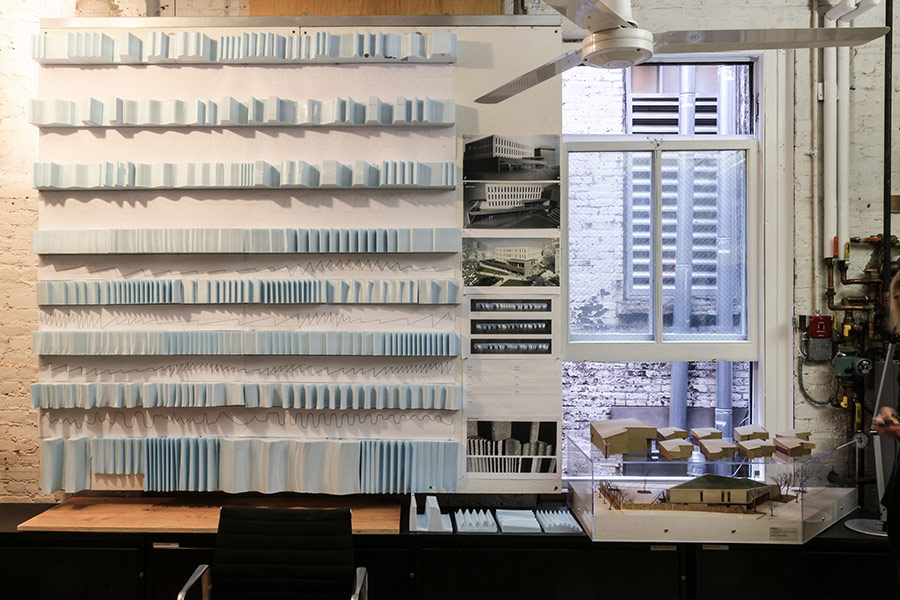
Since Henry Smith-Miller and Laurie Hawkinson founded the firm in 1982, and were joined in 2005 by Christian Uhl, they collectively have produced private and public architectural projects of the highest design quality. In a city like New York, where corporate firms and international brand names get most the large glamorous projects, it is easy to forget how good our own homegrown studios can be. The firm’s principles are role models of how to practice as professionals and stay involved in public debates and education. Both Smith-Miller and Hawkinson teach at major design schools in the Northeast and are committed to focusing the firm on institutional and government projects of the highest quality. Collectively they have remained engaged with contemporary culture.
But commitment to these issues is even more meaningful because the work coming from their design studio has proven to be carefully planned and executed. In all of their projects, they thoughtfully address the program and needs of the clients, but it is their meticulous attention to detail, from site placement (as demonstrated with their Second Dune Project) to the formal massing of their Corning Glass Studios that sets them apart from other designers. This fastidious approach is evident in every aspect of their work, including such features as the doors and handrails, which provide a more tactile experience of space.
The firm’s small office staff occupies one of the most charming old spaces left in Soho, whose snug layout encourages dialogue and fosters collaboration. They, unlike many firms in New York of their generation, have successfully completed projects in the city, but the bulk of their work is in other locales, from Upstate New York to California.
Second Dune House
East Hampton, New York
This 5,400-square-foot Long Island guesthouse is embedded into the second row of dunes back from the Atlantic Ocean—a ridge known as “Second Dune”—a strategically safer location than the volatile oceanfront. The ridge’s east-west orientation demanded a different plan from the traditional “Villa in the Park” estate. The first floor slips into the ridge and cascades down its southern slope with an outdoor terrace bookended by two outdoor pools and courts. Splayed first floor piers support a folded concrete plate green roof, with a terrace that offers second level outdoor space accessible by an outdoor stair.
Wilce Student Health Center
Columbus, Ohio
This 4,500-square-foot addition to the Wilce Student Health Center is located on the pedestrian West Mall of Ohio State University and is meant to accommodate a growing student population. A new textural precast facade, carefully developed in SMH’s studio, mimics the original building—a 1960s Marcel Breuer-type precast concrete construction. A rooftop terrace allows students and faculty to overlook the West Mall, creating social space for the medical facility.
Zerega Avenue EMS Station #3
Bronx, New York
EMS Station #3 is the first to implement the FDNY’s new comprehensive EMS program, improving response capability with more vehicles, staff, and support spaces for New York City. With a green roof landscape by Scape/ Landscape Architecture as a fifth facade for the adjacent Castle Hill Housing Towers, the design introduces FDNY vehicles into the neighborhood along with sustainable solutions, including reduced storm water, porous paving, captured storm water reuse, natural ventilation, and daylighting. Ventilation at the top of the mezzanine space takes advantage of prevailing winds that can be drawn through the garage doors to cool the space and dry wet equipment.
Hot Glass Theater, Corning Museum of Glass
Corning, New York
Smith-Miller + Hawkinson designed the Corning Museum of Glass, which opened in 2001. In 2012, Corning requested the original enclosed digital theater be retrofitted to accommodate the Hot Glass Show for 150 viewers. By opening the theater to the surrounding spaces, including the lobby, café, and landscape, the spectacle of glass blowing is visible to the entire museum. The project includes the design of all the glass blowing apparatuses as well as a custom ventilated stage and new seating. The space is designed with foamed aluminum panels to disperse heat and dampen sound, while lighting and digital displays are choreographed to respond to the artist’s production of glass objects.